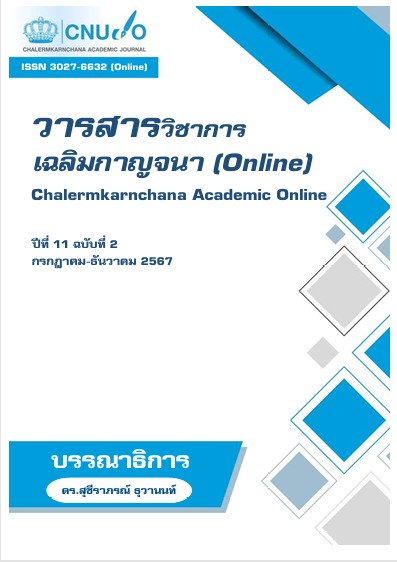Factors Influencing High School Students' Decision to Pursue Undergraduate Studies in Thailand
Keywords:
Higher education, Decision factors, High school students, University choice, Education policyAbstract
This study aims to analyze the factors influencing high school students' decision to pursue undergraduate education in Thailand. It focuses on five key aspects: personal factors, family influence, economic conditions, institutional factors, and government policies. A mixed-methods research approach was employed, combining quantitative data from 384 survey respondents and qualitative insights from in-depth interviews with relevant stakeholders.
The findings reveal that institutional and personal factors have the greatest influence on students' decisions, particularly curriculum quality (Mean = 4.35) and interest in the chosen field of study (Mean = 4.32). Additionally, parental support (Mean = 4.45) plays a crucial role among family factors. The availability of scholarships (Mean = 4.02) was found to have a greater impact than general educational expenses, while government policies (Mean = 3.97) had a moderate influence on students' choices.
The study suggests that (1) universities should enhance curriculum relevance to labor market demands and improve career counseling services, (2) families should play a more active role in supporting students' educational decisions, and (3) the government should improve the accessibility of scholarships and develop more flexible financial support mechanisms for students. These findings provide insights for educational policymakers and institutions to promote higher education enrollment in Thailand.
References
Becker, G. S. (1993). Human capital: A theoretical and empirical analysis, with special
reference to education (3rd ed.). The University of Chicago Press.
Bourdieu, P. (1986). The forms of capital. In J. Richardson (Ed.), Handbook of Theory and
Research for the Sociology of Education (pp. 241–258). Greenwood.
Cabrera, A. F., & La Nasa, S. M. (2000). Understanding the college choice process. New
Directions for Institutional Research, 2000(107), 5-22.
Chapman, D. W. (1981). A model of student college choice. The Journal of Higher
Education, 52(5), 490-505.
Choy, S. P. (2001). Students whose parents did not go to college: Postsecondary access,
persistence, and attainment. National Center for Education Statistics, U.S. Department
of Education.
Eccles, J. S., Barber, B. L., Stone, M., & Hunt, J. (2004). Extracurricular activities and
adolescent development. Journal of Social Issues, 59(4), 865-889.
Hossler, D., & Gallagher, K. S. (1987). Studying student college choice: A three-phase model
and the implications for policymakers. College and University, 62(3), 207-221.
Hossler, D., Schmit, J., & Vesper, N. (1999). Going to college: How social, economic, and
educational factors influence the decisions students make. Johns Hopkins University
Press.
Kotler, P., & Fox, K. F. A. (1995). Strategic marketing for educational institutions (2nd ed.).
Prentice Hall.
Maslow, A. H. (1943). A theory of human motivation. Psychological Review, 50(4), 370-396.
McDonough, P. M. (1997). Choosing colleges: How social class and schools structure
opportunity. State University of New York Press.
OECD. (2018). Education at a glance 2018: OECD indicators. Organisation for Economic Co-
operation and Development.
Pascarella, E. T., & Terenzini, P. T. (2005). How college affects students: A third decade of
research (Vol. 2). Jossey-Bass.
Paulsen, M. B., & St. John, E. P. (2002). Social class and college costs: Examining the
financial nexus between college choice and persistence. The Journal of Higher
Education, 73(2), 189-236.
Perna, L. W. (2006). Studying college choice: A proposed conceptual model. Higher
Education: Handbook of Theory and Research, 21, 99-157.
Thailand Ministry of Education. (2021). Higher education development policy and financial
support programs.
UNESCO. (2020). Education in the COVID-19 era: Opportunities and challenges. United
Nations Educational, Scientific and Cultural Organization.
กระทรวงศึกษาธิการ. (2564). รายงานสถิติการศึกษาของประเทศไทย ประจำปี 2564. สำนักนโยบาย
และยุทธศาสตร์.
สำนักงานคณะกรรมการการอุดมศึกษา. (2564). แนวทางการพัฒนาการศึกษาและทุนการศึกษาสำหรับ
นักเรียนมัธยมศึกษาตอนปลาย.
สำนักงานสถิติแห่งชาติ. (2565). รายงานภาวะการศึกษาไทย: การศึกษาต่อของนักเรียนมัธยมศึกษาตอน
ปลาย.
Published
How to Cite
Issue
Section
License
Copyright (c) 2025 Chalermkarnchana Academic Journal

This work is licensed under a Creative Commons Attribution-NonCommercial-NoDerivatives 4.0 International License.






